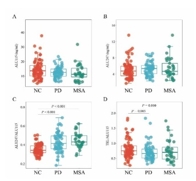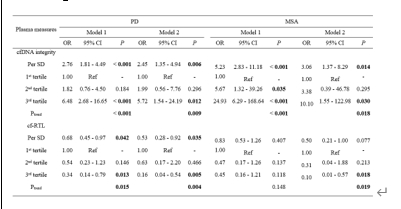中国神经再生研究(英文版) ›› 2025, Vol. 20 ›› Issue (12): 3553-3563.doi: 10.4103/NRR.NRR-D-24-00599
血浆循环游离DNA完整性和相对端粒长度作为帕金森病和多系统萎缩的诊断生物标志物:横断面研究
Plasma circulating cell–free DNA integrity and relative telomere length as diagnostic biomarkers for Parkinson’s disease and multiple system atrophy: a cross-sectional study
Chao Ying1, 2, 3, 4, #, Chao Han4, #, Yuan Li5, #, Mingkai Zhang5 , Shuying Xiao5 , Lifang Zhao6 , Hui Zhang5 , Qian Yu7 , Jing An4 , Wei Mao5, *, Yanning Cai1, 2, 3, 4, 6, *
- 1 Department of Neurobiology, Xuanwu Hospital, Capital Medical University, Beijing, China; 2 Beijing Municipal Geriatric Medical Research Center, Beijing, China; 3 Key Laboratory for Neurodegenerative Diseases of the Ministry of Education, Beijing Key Laboratory of Parkinson’s Disease, Parkinson’s Disease Center for Beijing Institute on Brain Disorders, Clinical and Research Center for Parkinson’s Disease, Capital Medical University, Beijing, China; 4 National Clinical Research Center for Geriatric Disorders, Xuanwu Hospital, Capital Medical University, Beijing, China; 5 Department of Neurology, Xuanwu Hospital, Capital Medical University, Beijing, China; 6 Department of Clinical Biobank and Central Laboratory, Xuanwu Hospital, Capital Medical University, Beijing, China; 7 School of Health Professions, Stony Brook University, Stony Brook, NY, USA
摘要:
帕金森病和多系统萎缩都被归类为α-突触核蛋白病,其特征是α-突触核蛋白的异常积聚,这为它们的比较研究提供了共同的病理背景。此外,帕金森病和多系统萎缩都涉及神经元死亡,这一过程可能会将循环游离DNA释放到血液中,导致其特征的特定改变。这一前提为研究循环游离DNA作为潜在生物标志物奠定了基础。循环游离DNA因其潜在的病理意义而受到关注,但其在帕金森病和多系统萎缩背景下的特征尚不完全清楚。此研究分析了62例帕金森病和33例多系统萎缩患者的血浆循环游离DNA特征,包括循环游离DNA总浓度、非凋亡来源的循环游离DNA水平、循环游离DNA完整性和相对端粒长度(cell free DNA relative telomere length, cf-RTL),以76名健康者为正常对照组。结果显示,与NC相比,帕金森病和多系统萎缩患者的循环游离DNA完整性显著提高,而相对端粒长度显著缩短。ROC分析表明,循环游离DNA完整性和相对端粒长度在区分帕金森病和多系统萎缩与正常对照组方面具有良好的诊断准确性。具体而言,较高的循环游离DNA完整度与帕金森病(OR: 5.72;95% CI: 1.54-24.19)和多系统萎缩(OR: 10.10;95% CI: 1.55-122.98)的风险增加有关。相反,较长的相对端粒长度与帕金森病(OR: 0.16;95% CI: 0.04-0.54)和多系统萎缩(OR:0.10;95% CI:0.01-0.57)的风险降低有关。这些结果表明,血浆循环游离DNA完整性和相对端粒长度在帕金森病和多系统萎缩中的诊断潜力,表明这些特性不仅可作为早期辅助诊断的生物标志物,还可能反映疾病的潜在病理机制。
https://orcid.org/0000-0002-7690-9013 (Wei Mao); https://orcid.org/0000-0003-0879-9809 (Yanning Cai)


 #br#
#br#